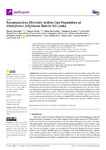2022-04-02Zeitschriftenartikel
Paramyxovirus Diversity within One Population of Miniopterus fuliginosus Bats in Sri Lanka
Muzeniek, Therese
Perera, Thejanee
Siriwardana, Sahan
Bayram, Fatimanur
Bas, Dilara
Öruc, Mizgin
Becker-Ziaja, Beate
Perera, Inoka
Weerasena, Jagathpriya
Handunnetti, Shiroma
Schwarz, Franziska
Premawansa, Gayani
Premawansa, Sunil
Yapa, Wipula
Nitsche, Andreas
Kohl, Claudia
Bats are known as typical reservoirs for a number of viruses, including viruses of the family Paramyxoviridae. Representatives of the subfamily Orthoparamyxovirinae are distributed worldwide and can cause mild to fatal diseases when infecting humans. The research on Paramyxoviruses (PMVs) from different bat hosts all over the world aims to understand the diversity, evolution and distribution of these viruses and to assess their zoonotic potential. A high number of yet unclassified PMVs from bats are recorded. In our study, we investigated bat species from the families Rhinolophidae, Hipposiderae, Pteropodidae and Miniopteridae that are roosting sympatrically in the Wavul Galge cave (Koslanda, Sri Lanka). The sampling at three time points (March and July 2018; January 2019) and screening for PMVs with a generic PCR show the presence of different novel PMVs in 10 urine samples collected from Miniopterus fuliginosus. Sequence analysis revealed a high similarity of the novel strains among each other and to other unclassified PMVs collected from Miniopterus bats. In this study, we present the first detection of PMVs in Sri Lanka and the presence of PMVs in the bat species M. fuliginosus for the first time.
Files in this item

